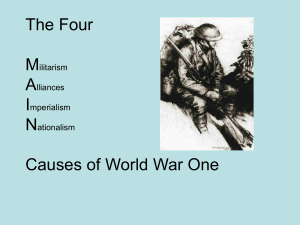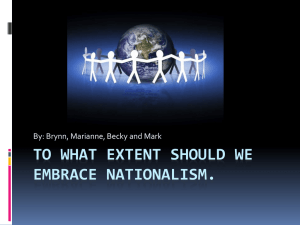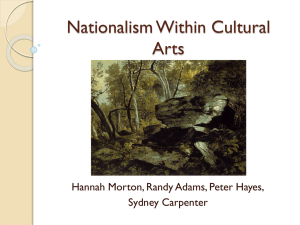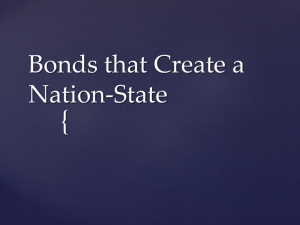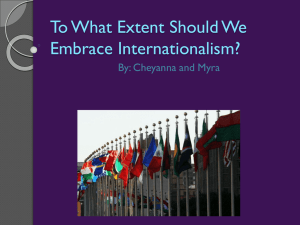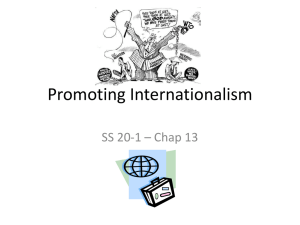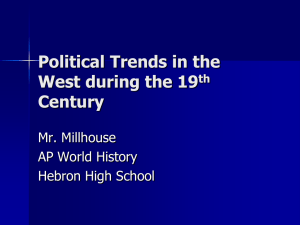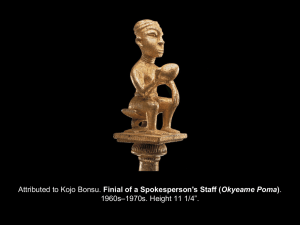Themes of 20th century history
advertisement
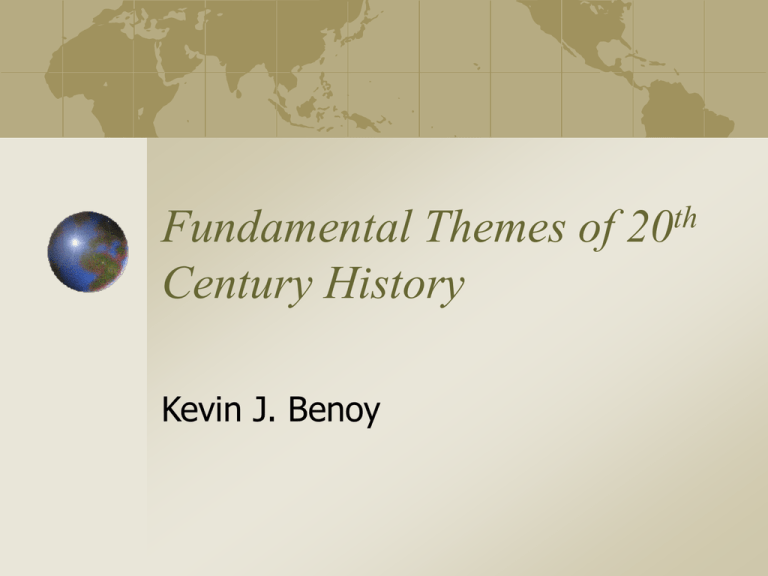
Fundamental Themes of 20th Century History Kevin J. Benoy I. The Impact of Nationalism and Imperialism in the 20th Century Nationalism A feeling which leads people to desire unity, freedom and complete control over their own affairs. It unites people and disrupts empires. Nationalism It often leads to intense feelings of pride in one’s own country. When this is excessive, it is called chauvenism or jingoism. Nationalism Nationalism led to Italian and German unification. It brought the collapse of the Ottoman & Austro-Hungarian Empires. It contributed to causing WW1 and WWII. It caused the disintegration of the Soviet Union. Quebecois nationalism threatens Canada. Civic & Ethnic Nationalism A key question for nationalists is “Who should belong to the nation?” Civic Nationalism This gives membership to all those born in a country and to those who commit to supporting it. Such nationalism is blind to race, colour, creed, gender, language, or ethnicity so long as members subscribe to the nation’s political creed. This nationalism is created by the state. Ethnic Nationalism This argues that it is not the state that creates the nation, but the people who create the state. Belonging is a matter of blood. Four Stages of Nationalism Integrative Nationalism (18151871) This served as a unifying force, leading to the creation of nation states such as Italy and Germany Disruptive Nationalism (18711890) Minority groups clamored for independence from AustriaHungary and the Ottoman Empire. Aggressive Nationalism (19001945) Opposing national forces collided. This was a major cause of both world wars. Contemporary Nationalism (1945 to present) This includes the retreat from colonialism, the collapse of the Soviet “Empire” and reaction to American global supremacy. Imperialism This is the deliberate attempt by the people of one country to extend their rule over the people of other areas – against their wishes. Old Imperialism This began with the voyages of Columbus and Vasco da Gama in the late 15th century. It involved “God, Gold and Glory.” This ended with the effects of the industrial revolution, the Napoleonic Wars and the problems of social and political reform in the 19th century. New Imperialism This dates to around the 1870’s. The old motivations were still present. National pride and Social Darwinism are added to the mix. Imperialists called on their people to assume the “White Man’s Burden”. Consequences of the New Imperialism Imperial interests collided. Imperial Disputes France and Britain nearly went to war in 1898, during the Fashoda Incident. Imperial Disputes Britain and Russia were in conflict over control of Iran and Afghanistan. Imperial Disputes Russia and Japan conflicted over control of Manchuria. Imperial Disputes Germany and France vied for influence in Morocco. Imperial Disputes Britain and the United States risked war in their dispute over the AlaskanCanadian border. Degrees of Imperialism Concession This is a right given up by one society to another. It might be political or economic – like France’s rights in Morocco or the extraterritorial rights of many of the powers in China. Sphere of Influence This involves one society having some ability to control the behavior of another. The influence of the USA over Latin American countries would be a good example. Protectorate or Dependency These terms denote open admission that one country controls another in terms of protection. Colony This involves a high degree of control, in which the mother country runs the internal affairs of the subject state. Annexation This involves a complete takeover or absorption. Good examples of this include France’s control over Algeria and the USA and Russia’s takeover of huge land masses. Neo-Imperialism This is characteristic of the post-1945 era, in which the superpowers exercised either political, economic, or ideological control over parts of the world. It happened alongside the retreat from colonialism. II. The Role of the Individual in History Great Men and Women The 20th century saw many significant figures. Some were event-making. Others were eventful. Everyman Social History devotes itself to the study of ordinary people and their influence on events. What would have happened if Londoners had collapsed in the Blitz? What if Russians had collapsed to the Nazis? What if Germans rejected Hitler? III. The Nature of Conflict and Conflict Resolution Militarism This implies a belief in war as a means of achieving national aims. It also suggests the values of a society which derives national pride from military armament. Prussia was an outstanding example of 19th century militarism, as was Germany in the early 20th century Militarism British pride in its naval dominance in the 19th and early 20th centuries is another example of this force. Militarism The arms race prior to WWI and rearmament before WWII show the importance of military solutions to national problems. The Cold War was another period of intense military development. War in the 20th Century This century introduced man to total war. The world wars required the resources of every level of society and every citizen. They also resulted in destruction on an unprecedented scale. War in the 20th Century The development of nuclear weapons brought man to the brink of mutual assured destruction, and made war between nuclear powers almost unthinkable – except through human error. War in the 20th Century The risks of total war encouraged the powers to fight limited wars in fringe areas, like Korea or Vietnam or to test equipment and tactics in proxy wars involving their lesser allies. War in the 20th Century In the face of the overwhelming strength of the USA or regional powers since the end of the Cold War, weaker adversaries began to adopt new tactics in what has become known as asymmetrical warfare. Usually this is called terrorism, as the enemy wears no uniform and may use unconventional weapons. Conflict Resolution Deterrence failed when the alliance systems before World War I resulted in continental war. Conflict Resolution Collective security through international cooperation was tried, but failed, in the interwar years. Conflict Resolution Since World War II, international cooperation through the United Nations has sometimes maintained peace. Conflict Resolution Treaties of all kinds were employed since 1919 to force conflict resolution and prevent war. Success was never complete, but much was accomplished nonetheless. IV. The Growth of Internationalism in the 20th Century Internationalism Some believe the ultimate loyalty is not to the nation, but to the human race. Internationalism Some 19th century organizations were dedicated to this belief. The International Red Cross. The Universal Postal Union. Internationalism Some 19th century writers dedicated themselves to the peace movement. Victor Hugo Leo Tolstoy Internationalism Prominent industrialists like Andrew Carnegie and Alfred Nobel used their fortunes to foster international cooperation. The Nobel Peace Prize is still awarded. Internationalism Two Peace conferences were held at the Hague in 1899 and 1907 to regulate and limit war. Some weapons were outlawed – like the dum dum bullet . They did not discuss outlawing war itself. Modern Internationalism The two most important international organizations of the 20th century were the League of Nations and the United Nations. Internationalism The League failed to prevent World War II, but did resolve lesser conflicts. The League’s agencies survived the death of the parent organization and are now part of the United Nations Organization. Internationalism The UN failed to prevent a host of conflicts, but remains a potent and important force for peace. All major crises are debated here. Internationalism Many organizations promote internationalism, from the Commonwealth and Francophonie to the Olympic movement. V. The Changing Role of the Individual in Society The Individual in Society Huge changes in roles and attitudes took place in the 20th century. We moved from Social Darwinism to Multiculturalism. The Role of Women evolved substantially. Pay particular attention to chapters in Howarth entitled People and Societies as they chronicle these shifts. VI. The Impact of Dominant Political Philosophies in the 20th Century Ideologies Be sure to review what we studied in Social Studies 11. Totalitarianism Authoritarianism Autocracy Democracy Communism Socialism Liberalism Conservatism Fascism Democracy & Totalitarianism These are best understood in contrast to each other. Deomocracy Democracy seeks to allow each individual to develop in a society of maximum freedom and mutual respect. Social controls exist – but to enhance individual self-development and not the power of the state. The individual is the master. Totalitarianism The goal is total control of man by the state or social class as represented by the state. There are no limits to goals or means. Totalitarianism A totalitarian system wants all of man, body and soul to submit to the will of the government. There is no human activity exempt from government control. Totalitarianism The government is the master; the individual is the servant. There are no inalienable rights. Modern totalitarianism found success through using science and technology as tools of state repression. Totalitarianism Totalitarian states often borrow symbols, techniques and institutions from democracies. People are allowed to express consent in the form of elections or plebiscites where results are carefully controlled or monitored. VII. The Impact of Technological and Economic Change in the 20th Century Industrialization and Globalization The 20th century saw huge increases in the production of goods. It also saw tremendous integration of regional economies into a global whole. Industrialization Production increases unleashed first European and then American and Asian might. It sustained totalitarianism and democracy. Industrialization Warfare in the 20th century was driven by technological developments. Industrialization Major economic trends , like the Great Depression of the 1930’s or German hyperinflation were closely tied to the management of industrial production. Globalization By the end of the 20th century, most of the world was part of a single, integrated production and trading unit. However, not all have shared in the wealth that has been generated. Technological and Economic Change A key question for the 20th century is: “Has man been controlled by technological development or has technological development controlled man?” finis

